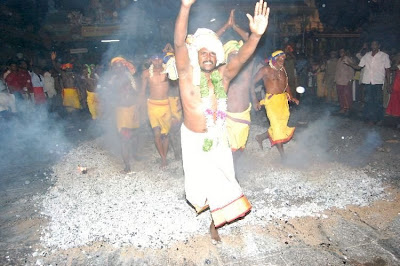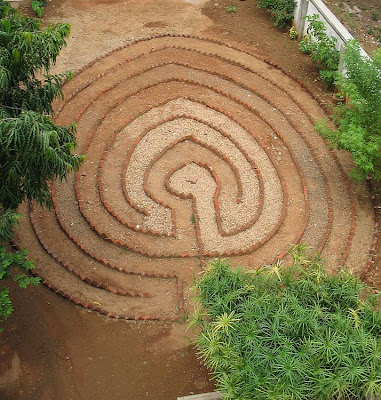Fire walking is still a regular event in Tiruvannamalai and other South Indian towns. Usually wood or charcoal is burnt and the smouldering embers laid out onto the ground. Commonly the ceremony is held under the auspices of a Temple, and in the case of Arunachaleswarar Temple the occurrence takes place once year. This year the Fire Walking ceremony took place around 2 a.m. this morning in front of the Unnamulaiamman Shrine at the Arunachaleswarar Temple, which was specially kept open for the function.

Many hundreds of devotees turned up for the ceremony, but the fire walking itself was only undertaken by devotees of the Divine Mother who had been observing special procedures over the previous 30 days (including fast) in order to prepare themselves for the ‘test of devotion’. Those who participated were ordinary householders and largely non-Brahmins. In some cases devotees were given a mantra to recite during their fire walk.


In all Temples, where the fire-walking ceremony is practised, it is a Goddess that is worshipped. In the case of the Arunachaleswarar Temple, it is the Goddess Unnamulai that is duly placated.
The actual ceremony occurs on the paved courtyard in front of the Unnamulaiamman Shrine, inside the compound of the Big Temple, a fixed day during the month of Adi (mid-July to mid-August). At that time a fire of burning embers is spread out after midnight for people to walk upon.

A Tamil legend narrates the story that in Singavaram there is a Temple to Sri Ranganadha. Here a king named Kandhan, after suffering a defeat, performed a fire walking ceremony in worship of Draupadi (from the Mahabharata). Draupadi, pleased with the worship, appeared before the king and promised that whoever should worship her as he had done would remain unscathed and also obtain whatever they prayed for. From that day onwards the fire-walking festival is observed with great enthusiasm in Tamil Nadu.
In the upcoming Arunachala Grace Newsletter there will be a narrative explaining the history and esoteric significance of the fire walking ceremony as it is performed at the Unnamulaiamman Shrine at Arunachaleswarar Temple.

If you are not receiving your copy of the bi-monthly Newsletter direct to your email inbox, please visit the Newsletter subscribe facility which you can find at the left column margin of this page.


High quality professional photographs of the actual fire walking will be posted in the upcoming week. Please keep checking back to view updates of this ceremony.





















































